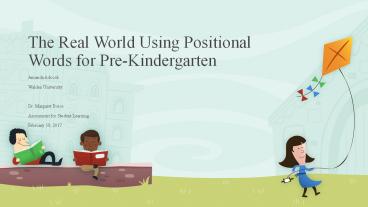Pre-K Positional Words - PowerPoint PPT Presentation
Title:
Pre-K Positional Words
Description:
Teaching positional words to pre-k students. – PowerPoint PPT presentation
Number of Views:175
Title: Pre-K Positional Words
1
The Real World Using Positional Words for
Pre-Kindergarten
- Amanda Adcock
- Walden University
- Dr. Margaret Boice
- Assessment for Student Learning
- February 19, 2017
2
Contents
- Unit Overview
- Theme of the Unit
- Standards
- Learning Goals
- Enduring Understandings
- Essential Questions
- Pre-Assessment
- Family Survey
- Activities for Learning
- Formative Assessment
- Summative Assessment
- Rubric
- Motivation
3
When children begin to describe locations of
people, places and things using words such as in
front of, behind, next to, above, below, besides,
on top of, inside, outside, etc., children begin
to build vocabulary development as well as
understand their place within the world,
geographically speaking.
- Unit Overview
4
Using the familiar stories of Pete the Cat
Wheels on the Bus and Were Going on a Bear
Hunt, children will be immersed in activities
that promote the use of positional words that
define location of people, places and things in a
manner that is fun, engaging and educational.
Theme of Unit
5
PKSS2 Students identify locations of people,
places, and features of the physical environment
where they live and describe the relationship
between that place and other places (Teaching
Strategies GOLDTM Objectives for Development ...
n.d.).PKSS2.a Use positional terms to
describe the location of people and objects
(Teaching Strategies GOLDTM Objectives for
Development ... n.d.).
- Standards
6
Students will be able to position themselves in
relation to other people, places, and things
within the classroom with 80 accuracy.Students
will be able to identify the location of people,
places, and things with 80 accuracy.Students
will be able to create maps of people, places,
and things of items within the classroom with 80
accuracy.
- Learning Goals
7
Students will understand that all items within
their immediate world are positioned in relation
to another item (behind, in front of, beside, up,
down, etc.) and be able to apply the knowledge
of positional words with 80 accuracy(Teaching
Strategies GOLDTM Objectives for Development ...
n.d).
- Enduring Understandings
8
During Circle Time, students will be asked the
followingDiscussion What is a positional
word? Discussion Is your house near or
far? Discussion Describe where the nearest
store is to your house? Discussion If I could
not see, describe how I would get into this class
from the car?
- Essential Questions
9
Before the unit is discussed, study of the data
shows that the children are not versed in giving
and applying directions as noted from anecdotal
observations. Simply asking the children
positional questions renders answers by some that
are intelligible and allows for detailed
descriptions while others lack in the vocabulary
to even attempt to describe locations of people,
places and things.
- Pre-Assessment
10
- Family Survey
11
Using the familiar stories of Pete the Cat
Wheels on the Bus and Were Going on a Bear
Hunt, children will be immersed in activities
that promote the use of positional words that
define location of people, places and things in a
manner that is fun, engaging and educational.
Activities for Learning
12
Using the guided questions that follow the story,
children will be able to demonstrate
understanding by pointing out their answers
within the story. The use of manipulatives to
create real-life kinesthetic understanding will
also be utilized to further demonstrate
understanding.
- Formative Assessment
13
Creating Maps using a variety of media.
Previous examples can be discussed to gauge
further learning and understanding.
- Summative Assessment
14
- Rubric
15
Get ready to learn because we are going to have a
lot of fun and rock out like Pete the Cat!
16
References
- Dean, J. (2013). The wheels on the bus. New York
Harper. - Schoenberger, C. (n.d.). Pete Positional Words
Script Web log post. Retrieved December 10,
2016, from https//docs.google.com/file/d/0Bx3vf-M
41rIjcnZfZWNEZzN5aUk/edit. - Teaching Strategies GOLDTM Objectives for
Development ... (n.d.). Retrieved November
2,2016, from http//teachingstrategies.com/content
/pageDocs/DODEA-GOLD-Alignment-Pre-K-2011.pdf. p.
18.































